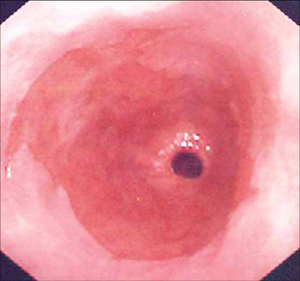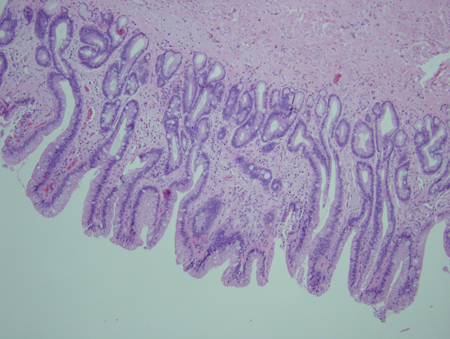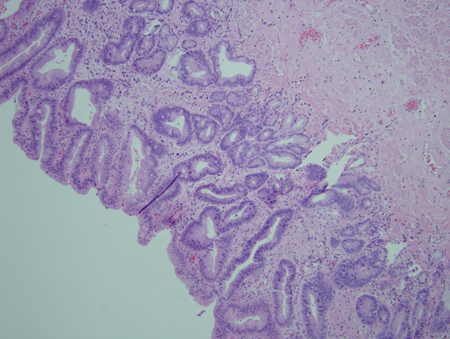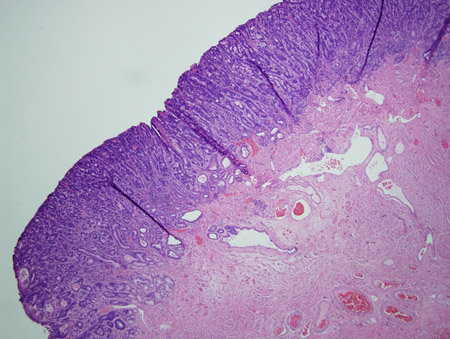Approach
Barrett esophagus is a histologic diagnosis, and endoscopy with mucosal biopsy is required to establish the diagnosis. The physical exam is essentially normal.
Symptoms
Key factors in the patient's history are symptoms of GERD:
Heartburn and regurgitation
Can occur during the day or at night
Many patients are asymptomatic.
Atypical symptoms include:
Chest pain
Voice changes (i.e., laryngitis)
Respiratory symptoms (i.e., reflux-induced asthma, reactive airway disease, or aspiration pneumonia)
Dysphagia (suggests advanced reflux, and may indicate stricture formation or ineffective esophageal motility).
See also Gastroesophageal reflux disease (Diagnosis Approach).
Upper GI endoscopy with biopsy
The key diagnostic test is upper GI endoscopy with identification of the mucosal changes of Barrett esophagus. High-resolution/high-definition white light endoscopy, with or without electronic chromoendoscopy, should be used for detailed inspection of the esophagus. Systematic endoscopic biopsies must be obtained cephalad to the anatomical gastroesophageal junction of all abnormal-appearing esophageal mucosa.[7] Pathologically, histology reveals columnar-lined epithelium with goblet cells, with or without dysplasia.[1][4][Figure caption and citation for the preceding image starts]: Barrett esophagus; note salmon-colored mucosa extending superior to the gastroesophageal junction as a continuous columnFrom the personal collection of Dr Vic Velanovich; used with permission [Citation ends]. [Figure caption and citation for the preceding image starts]: Barrett esophagus; note salmon-colored mucosa extending superior to the gastroesophageal junction with marked irregular borderFrom the personal collection of Dr Vic Velanovich; used with permission [Citation ends].
[Figure caption and citation for the preceding image starts]: Barrett esophagus; note salmon-colored mucosa extending superior to the gastroesophageal junction with marked irregular borderFrom the personal collection of Dr Vic Velanovich; used with permission [Citation ends]. [Figure caption and citation for the preceding image starts]: Barrett metaplasia without dysplasia, demonstrating columnar epithelium with goblet cells from superior to the gastroesophageal junctionCourtesy of Adrian Ormsby, MD, Henry Ford Hospital, Detroit, MI [Citation ends].
[Figure caption and citation for the preceding image starts]: Barrett metaplasia without dysplasia, demonstrating columnar epithelium with goblet cells from superior to the gastroesophageal junctionCourtesy of Adrian Ormsby, MD, Henry Ford Hospital, Detroit, MI [Citation ends]. [Figure caption and citation for the preceding image starts]: Barrett metaplasia with low-grade dysplasia; note the more irregular cells and nucleiCourtesy of Adrian Ormsby, MD, Henry Ford Hospital, Detroit, MI [Citation ends].
[Figure caption and citation for the preceding image starts]: Barrett metaplasia with low-grade dysplasia; note the more irregular cells and nucleiCourtesy of Adrian Ormsby, MD, Henry Ford Hospital, Detroit, MI [Citation ends]. [Figure caption and citation for the preceding image starts]: Barrett metaplasia with high-grade dysplasia; note more advanced irregularity of the cellsCourtesy of Adrian Ormsby, MD, Henry Ford Hospital, Detroit, MI [Citation ends].
[Figure caption and citation for the preceding image starts]: Barrett metaplasia with high-grade dysplasia; note more advanced irregularity of the cellsCourtesy of Adrian Ormsby, MD, Henry Ford Hospital, Detroit, MI [Citation ends]. [Figure caption and citation for the preceding image starts]: Barrett metaplasia with high-grade dysplasia associated with a focus of intramucosal carcinoma; note the frankly malignant cells beyond the confines of the basement membrane to involve the lamina propriaCourtesy of Adrian Ormsby, MD, Henry Ford Hospital, Detroit, MI [Citation ends].
[Figure caption and citation for the preceding image starts]: Barrett metaplasia with high-grade dysplasia associated with a focus of intramucosal carcinoma; note the frankly malignant cells beyond the confines of the basement membrane to involve the lamina propriaCourtesy of Adrian Ormsby, MD, Henry Ford Hospital, Detroit, MI [Citation ends].
Upper GI contrast radiography
Barium esophagogram is still used by some clinicians as the initial diagnostic test in patients with dysphagia, as it is a noninvasive test with good sensitivity for the detection of structural abnormalities in the esophagus. Abnormal findings on barium esophagogram require confirmation and further endoluminal evaluation by endoscopy. The identification of a type I (sliding) hiatal hernia is common in patients with Barrett esophagus, and is an important risk factor for chronic gastroesophageal reflux.[34]
Emerging tests
Transnasal endoscopy permits office-based, unsedated evaluation of the esophagus, but requires a special, thin-caliber digital endoscope, which is not readily available in most practices.[35]
Capsule endoscopy using a specially designed video capsule (swallowed by the patient in the supine position) provides adequate images of the esophagus. However, it does not permit tissue sampling and its diagnostic characteristics are still suboptimal.[36]
A gelatin-coated sponge attached to a string can be swallowed by the patient and then pulled out, obtaining cytology samples from the distal esophagus. This removes the need for sedation or endoscopy, being performed using local anesthetic spray to reduce discomfort. Studies are ongoing but sponge cytology may be an acceptable alternative to endoscopy.[7]
Novel techniques aimed at discerning nondysplastic Barrett esophagus from dysplasia or neoplasia include chromoendoscopy (with the use of methylene blue, indigo carmine, or lugol's solution), autofluorescence imaging, confocal laser endomicroscopy, optical coherence tomography, and spectroscopy. However, the recommendations for use of these techniques in guidelines is mixed.[1][7][32]
Use of this content is subject to our disclaimer